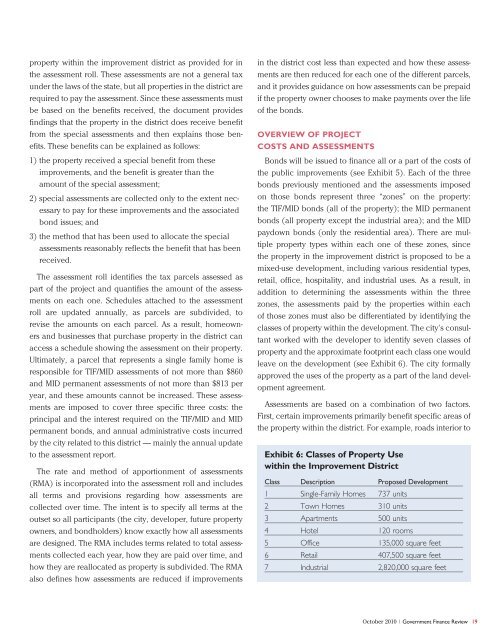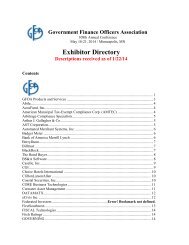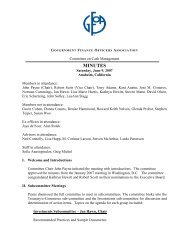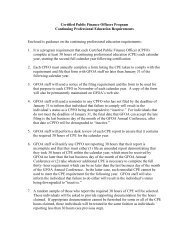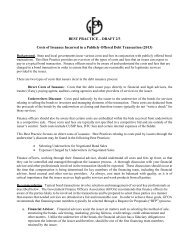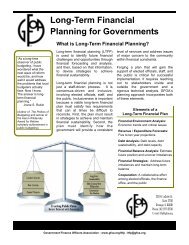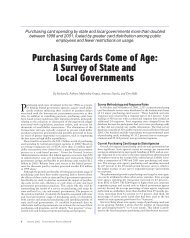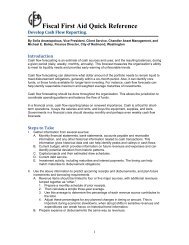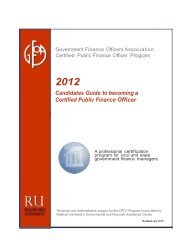a new era of development - Government Finance Officers Association
a new era of development - Government Finance Officers Association
a new era of development - Government Finance Officers Association
Create successful ePaper yourself
Turn your PDF publications into a flip-book with our unique Google optimized e-Paper software.
property within the improvement district as provided for in<br />
the assessment roll. These assessments are not a gen<strong>era</strong>l tax<br />
under the laws <strong>of</strong> the state, but all properties in the district are<br />
required to pay the assessment. Since these assessments must<br />
be based on the benefits received, the document provides<br />
findings that the property in the district does receive benefit<br />
from the special assessments and then explains those benefits.<br />
These benefits can be explained as follows:<br />
1) the property received a special benefit from these<br />
improvements, and the benefit is greater than the<br />
amount <strong>of</strong> the special assessment;<br />
2) special assessments are collected only to the extent necessary<br />
to pay for these improvements and the associated<br />
bond issues; and<br />
3) the method that has been used to allocate the special<br />
assessments reasonably reflects the benefit that has been<br />
received.<br />
The assessment roll identifies the tax parcels assessed as<br />
part <strong>of</strong> the project and quantifies the amount <strong>of</strong> the assessments<br />
on each one. Schedules attached to the assessment<br />
roll are updated annually, as parcels are subdivided, to<br />
revise the amounts on each parcel. As a result, homeowners<br />
and businesses that purchase property in the district can<br />
access a schedule showing the assessment on their property.<br />
Ultimately, a parcel that represents a single family home is<br />
responsible for TIF/MID assessments <strong>of</strong> not more than $860<br />
and MID permanent assessments <strong>of</strong> not more than $813 per<br />
year, and these amounts cannot be increased. These assessments<br />
are imposed to cover three specific three costs: the<br />
principal and the interest required on the TIF/MID and MID<br />
permanent bonds, and annual administrative costs incurred<br />
by the city related to this district — mainly the annual update<br />
to the assessment report.<br />
The rate and method <strong>of</strong> apportionment <strong>of</strong> assessments<br />
(RMA) is incorporated into the assessment roll and includes<br />
all terms and provisions regarding how assessments are<br />
collected over time. The intent is to specify all terms at the<br />
outset so all participants (the city, developer, future property<br />
owners, and bondholders) know exactly how all assessments<br />
are designed. The RMA includes terms related to total assessments<br />
collected each year, how they are paid over time, and<br />
how they are reallocated as property is subdivided. The RMA<br />
also defines how assessments are reduced if improvements<br />
in the district cost less than expected and how these assessments<br />
are then reduced for each one <strong>of</strong> the different parcels,<br />
and it provides guidance on how assessments can be prepaid<br />
if the property owner chooses to make payments over the life<br />
<strong>of</strong> the bonds.<br />
OVERVIEW OF PROJECT<br />
COSTS AND ASSESSMENTS<br />
Bonds will be issued to finance all or a part <strong>of</strong> the costs <strong>of</strong><br />
the public improvements (see Exhibit 5). Each <strong>of</strong> the three<br />
bonds previously mentioned and the assessments imposed<br />
on those bonds represent three “zones” on the property:<br />
the TIF/MID bonds (all <strong>of</strong> the property); the MID permanent<br />
bonds (all property except the industrial area); and the MID<br />
paydown bonds (only the residential area). There are multiple<br />
property types within each one <strong>of</strong> these zones, since<br />
the property in the improvement district is proposed to be a<br />
mixed-use <strong>development</strong>, including various residential types,<br />
retail, <strong>of</strong>fice, hospitality, and industrial uses. As a result, in<br />
addition to determining the assessments within the three<br />
zones, the assessments paid by the properties within each<br />
<strong>of</strong> those zones must also be differentiated by identifying the<br />
classes <strong>of</strong> property within the <strong>development</strong>. The city’s consultant<br />
worked with the developer to identify seven classes <strong>of</strong><br />
property and the approximate footprint each class one would<br />
leave on the <strong>development</strong> (see Exhibit 6). The city formally<br />
approved the uses <strong>of</strong> the property as a part <strong>of</strong> the land <strong>development</strong><br />
agreement.<br />
Assessments are based on a combination <strong>of</strong> two factors.<br />
First, certain improvements primarily benefit specific areas <strong>of</strong><br />
the property within the district. For example, roads interior to<br />
Exhibit 6: Classes <strong>of</strong> Property Use<br />
within the Improvement District<br />
Class Description Proposed Development<br />
1 Single-Family Homes 737 units<br />
2 Town Homes 310 units<br />
3 Apartments 500 units<br />
4 Hotel 120 rooms<br />
5 Office 135,000 square feet<br />
6 Retail 407,500 square feet<br />
7 Industrial 2,820,000 square feet<br />
October 2010 | <strong>Government</strong> <strong>Finance</strong> Review 19


